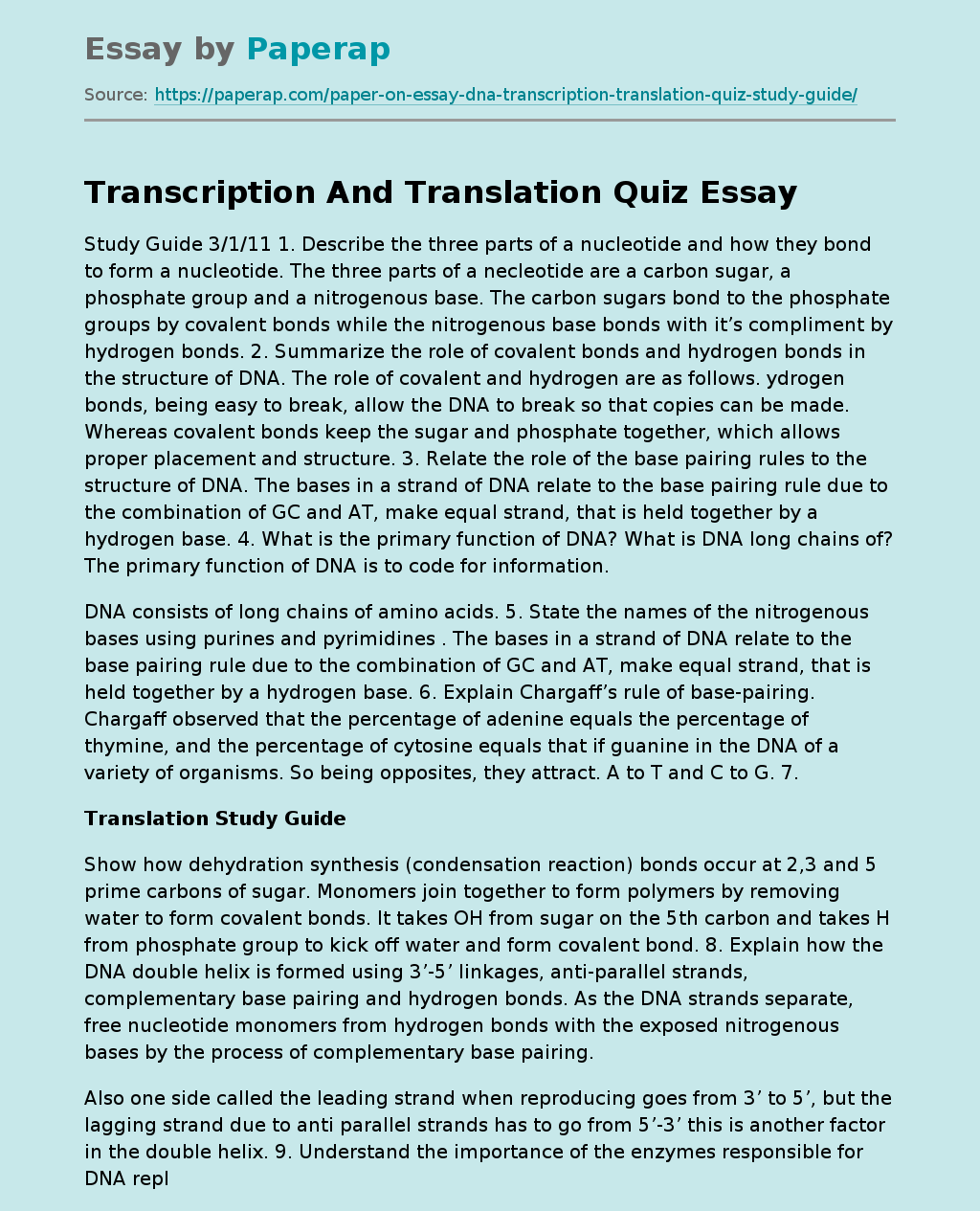Transcription And Translation Quiz
Study Guide 3/1/11 1. Describe the three parts of a nucleotide and how they bond to form a nucleotide. The three parts of a necleotide are a carbon sugar, a phosphate group and a nitrogenous base. The carbon sugars bond to the phosphate groups by covalent bonds while the nitrogenous base bonds with it’s compliment by hydrogen bonds. 2. Summarize the role of covalent bonds and hydrogen bonds in the structure of DNA. The role of covalent and hydrogen are as follows. ydrogen bonds, being easy to break, allow the DNA to break so that copies can be made.
Whereas covalent bonds keep the sugar and phosphate together, which allows proper placement and structure. 3. Relate the role of the base pairing rules to the structure of DNA. The bases in a strand of DNA relate to the base pairing rule due to the combination of GC and AT, make equal strand, that is held together by a hydrogen base. 4. What is the primary function of DNA? What is DNA long chains of? The primary function of DNA is to code for information.
DNA consists of long chains of amino acids. 5. State the names of the nitrogenous bases using purines and pyrimidines . The bases in a strand of DNA relate to the base pairing rule due to the combination of GC and AT, make equal strand, that is held together by a hydrogen base. 6. Explain Chargaff’s rule of base-pairing. Chargaff observed that the percentage of adenine equals the percentage of thymine, and the percentage of cytosine equals that if guanine in the DNA of a variety of organisms.
So being opposites, they attract. A to T and C to G. 7.
Translation Study Guide
Show how dehydration synthesis (condensation reaction) bonds occur at 2,3 and 5 prime carbons of sugar. Monomers join together to form polymers by removing water to form covalent bonds. It takes OH from sugar on the 5th carbon and takes H from phosphate group to kick off water and form covalent bond. 8. Explain how the DNA double helix is formed using 3’-5’ linkages, anti-parallel strands, complementary base pairing and hydrogen bonds. As the DNA strands separate, free nucleotide monomers from hydrogen bonds with the exposed nitrogenous bases by the process of complementary base pairing.
Also one side called the leading strand when reproducing goes from 3’ to 5’, but the lagging strand due to anti parallel strands has to go from 5’-3’ this is another factor in the double helix. 9. Understand the importance of the enzymes responsible for DNA replication. The role of helicases , and the role of poylmerases are as follows: polymerases add complementary nucleotides to each of the original strand of DNA, as well as replicating, and reparing. Helicases, on the other hand, separate the DNA strands, breaking the hydogen bonds between the complementary nitrogenous bases. 0. When and where does the process occur? What is the significance of DNA replication? In the nucleus for the purpose of repairing the body. 11. Explain semi-conservative replication and how it related to our outside simulation. DNA is a semi-conservative process because it uses half of the original DNA strand, and a new, freshly replicated stand. 12. Explain transcription. creating a complementary RNA copy of a sequence of DNA 13. Where does it occur? What is involved in the process? Transcription occurs in a the cells nucleus. 14.
Given a genetic code- be able to find amino acids based on the chart. Will do 15. Given a DNA strand, be able to find complementary strand, the mRNA to it, and the tRNA to the mRNA. Will do as well 16. During translation- what components must be aligned for the process to happen? Where does this occur? Why? Each of the 20 amino acids must be aligned with their corresponding codons. It occurs in the ribosome just as the strand is being ready to replicate to allow the correct amino acid to attach and align with the correct codon. 17.
What are the different types of RNA? Messenger RNA, Ribosomal RNA, and Transer RNA. 18. What are the differences between DNA and RNA? In DNA the A matches with a T and a G matches with a C, but in RNA goes from A to a U and G to C. Also RNA is in short one sided strands and DNA is in a double sided double helix long strand. 19. How is DNA changed into RNA? Why is it important for this process to occur? RNA Helicase attaches to the promoter and seperates the DNA in one section. Then the polymarase RNA comes and matches up with the DNA (AU)( GC). 0. How is DNA related to how proteins are made? Proteins are created from the messages the DNA send out in the form of RNA. Then the RNA is turned into a protein using amino acid chain that is made in the ribosome. 21. Explain what enzymes are significant to transcription. RNA polymerase and also DNA polymerase 22. Explain the process of translation. In translation, messenger RNA produced by transcription is decoded by the ribosome to produce a specific amino acid chain, or polypeptide, that will later fold into an active protein
Transcription And Translation Quiz. (2019, Dec 05). Retrieved from https://paperap.com/paper-on-essay-dna-transcription-translation-quiz-study-guide/

